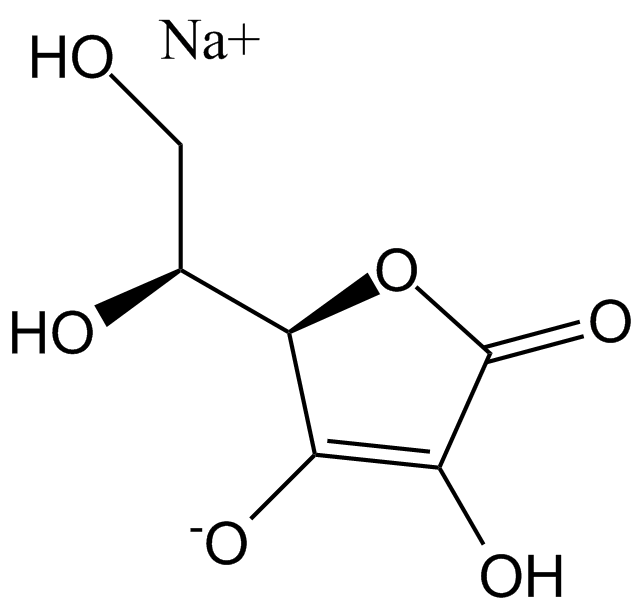Sodium ascorbate (Synonyms: Sodium L-ascorbate; Vitamin C sodium salt) |
| Catalog No.GC13616 |
L'ascorbate de sodium (L-ascorbate de sodium), donneur d'électrons, est un agent antioxydant endogène. L'ascorbate de sodium inhibe sélectivement les canaux Cav3.2 avec une IC50 de 6,5 μM. L'ascorbate de sodium est également un activateur de dépÔt de collagène et un inhibiteur de l'élastogenèse.
Products are for research use only. Not for human use. We do not sell to patients.

Cas No.: 134-03-2
Sample solution is provided at 25 µL, 10mM.
L-Ascorbic acid sodium salt is a more bioavailable form of vitamin C that is an antioxidant agent.
L-Ascorbic acid sodium salt, a known enhancer of collagen deposition, has also been identified as an inhibitor of elastogenesis[1]. The conditioned medium for B16F10 cells significantly inhibits cell apoptosis induced by sodium L-ascorbate (10 mM), and the effective ingredients in the medium show a relative molecular mass below 5,000[2].
Tg rats treated with sodium L-ascorbate show a higher incidence of carcinoma (29.6%), compared to those without sodium L-ascorbate (15.4%). Independent of the sodium L-ascorbate treatment, transgenic rats exhibit various kinds of malignant tumors in various organs[3]. After 12 weeks of PEITC-treatment, both simple hyperplasia and papillary or nodular (PN) hyperplasia have developed in all animals, but the majority of these lesions have disappeared at week 48, irrespective of the sodium L-ascorbate-treatment. The same lesions after 24 weeks of PEITC-treatment have progressed to dysplasia and carcinoma, in a small number of cases by week 48, but enhancement by the sodium L-ascorbate-treatment is evident only with simple hyperplasias and PN hyperplasias in rats[4].
References:
[1]. Hinek A, et al. Sodium L-ascorbate enhances elastic fibers deposition by fibroblasts from normal and pathologic human skin. J Dermatol Sci. 2014 Sep;75(3):173-82.
[2]. Yang X, et al. Mouse melanoma cell line B16F10-derived conditioned medium inhibits sodium L-ascorbate-induced B16F10 cell apoptosis. Nan Fang Yi Ke Da Xue Xue Bao. 2012 Feb;32(2):146-50.
[3]. Morimura K, et al. Lack of urinary bladder carcinogenicity of sodium L-ascorbate in human c-Ha-ras proto-oncogene transgenic rats. Toxicol Pathol. 2005;33(7):764-7.
[4]. Takagi H, et al. Limited tumor-initiating activity of phenylethyl isothiocyanate by promotion with sodium L-ascorbate in a rat two-stage urinary bladder carcinogenesis model. Cancer Lett. 2005 Mar 10;219(2):147-53.
Average Rating: 5 (Based on Reviews and 9 reference(s) in Google Scholar.)
GLPBIO products are for RESEARCH USE ONLY. Please make sure your review or question is research based.
Required fields are marked with *




















